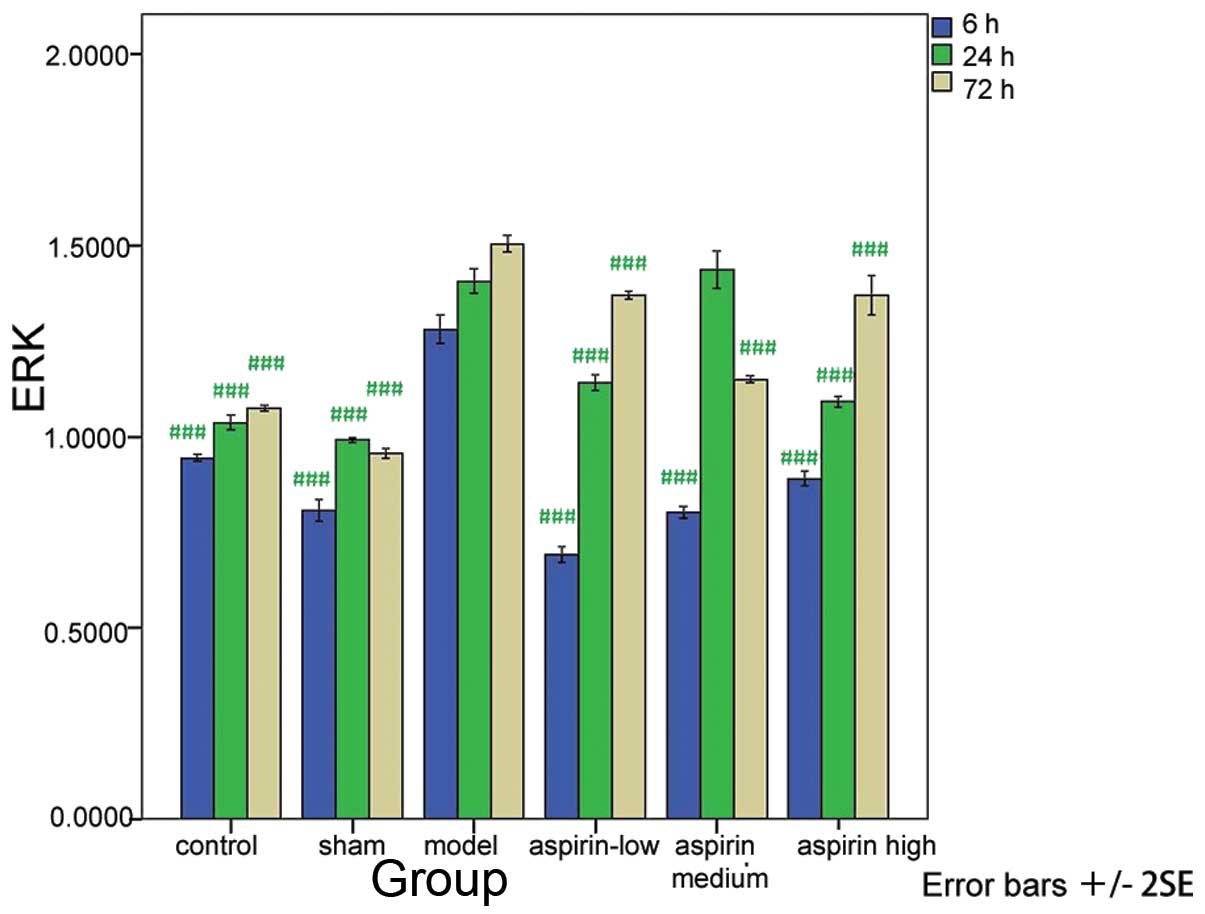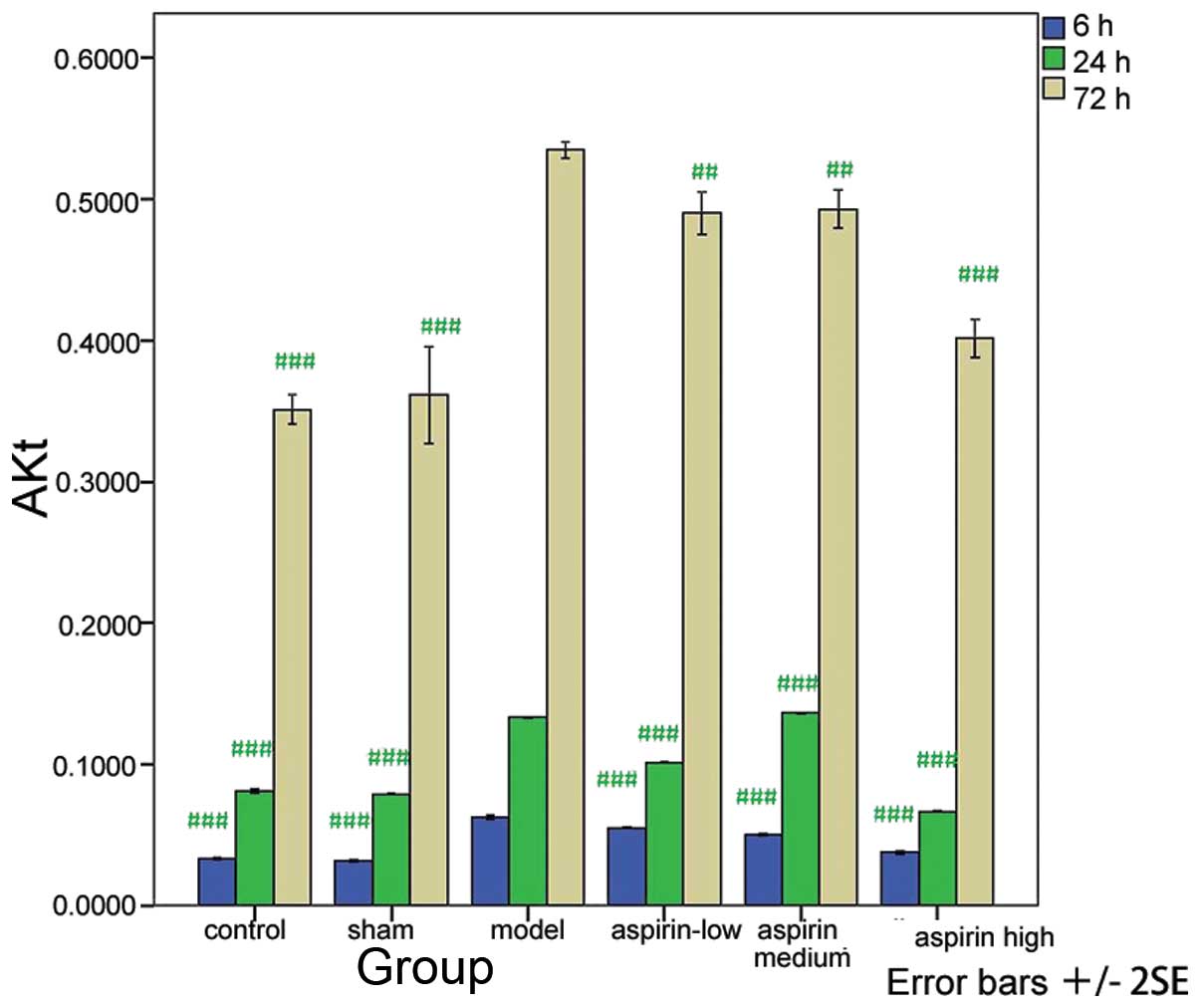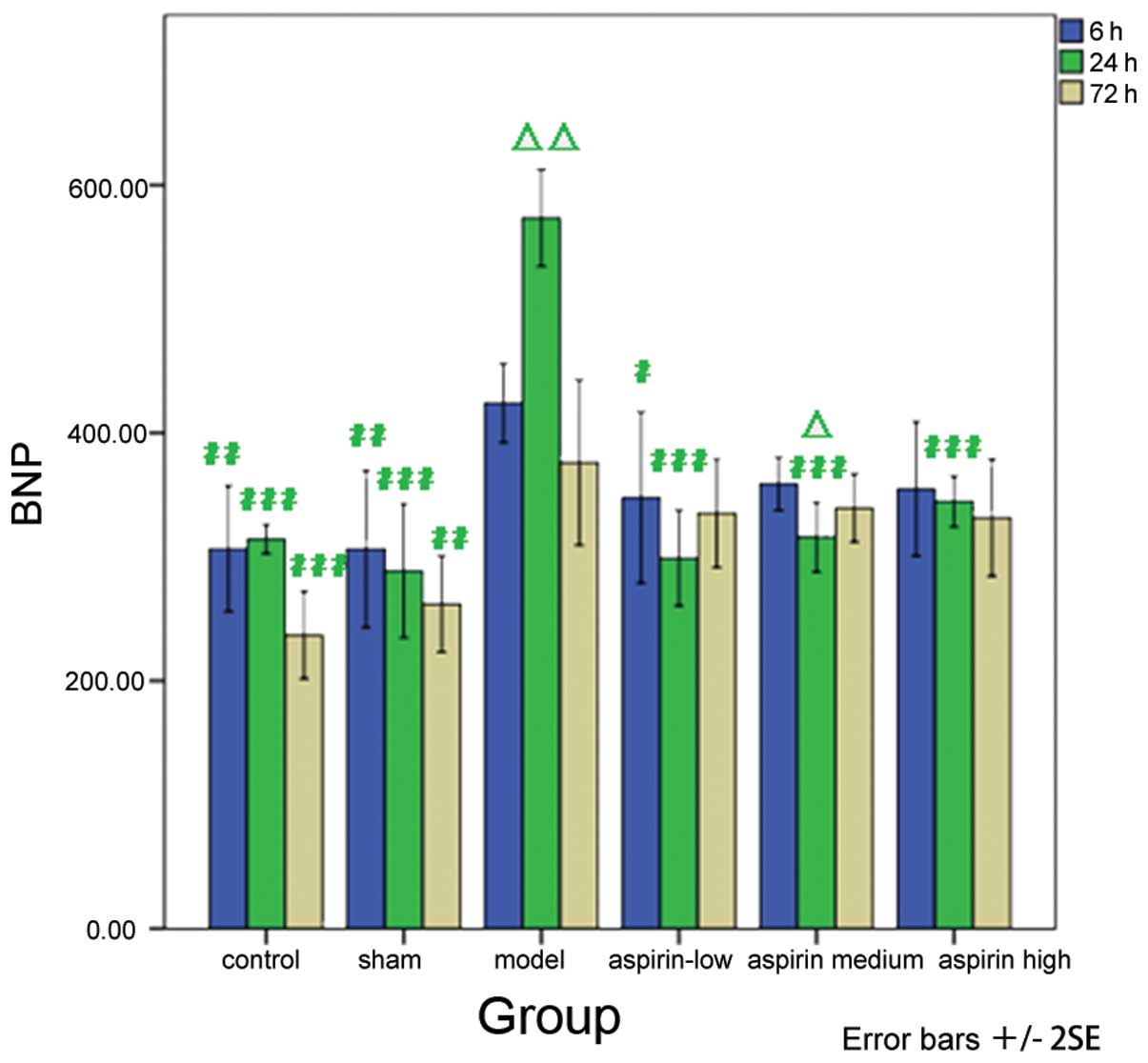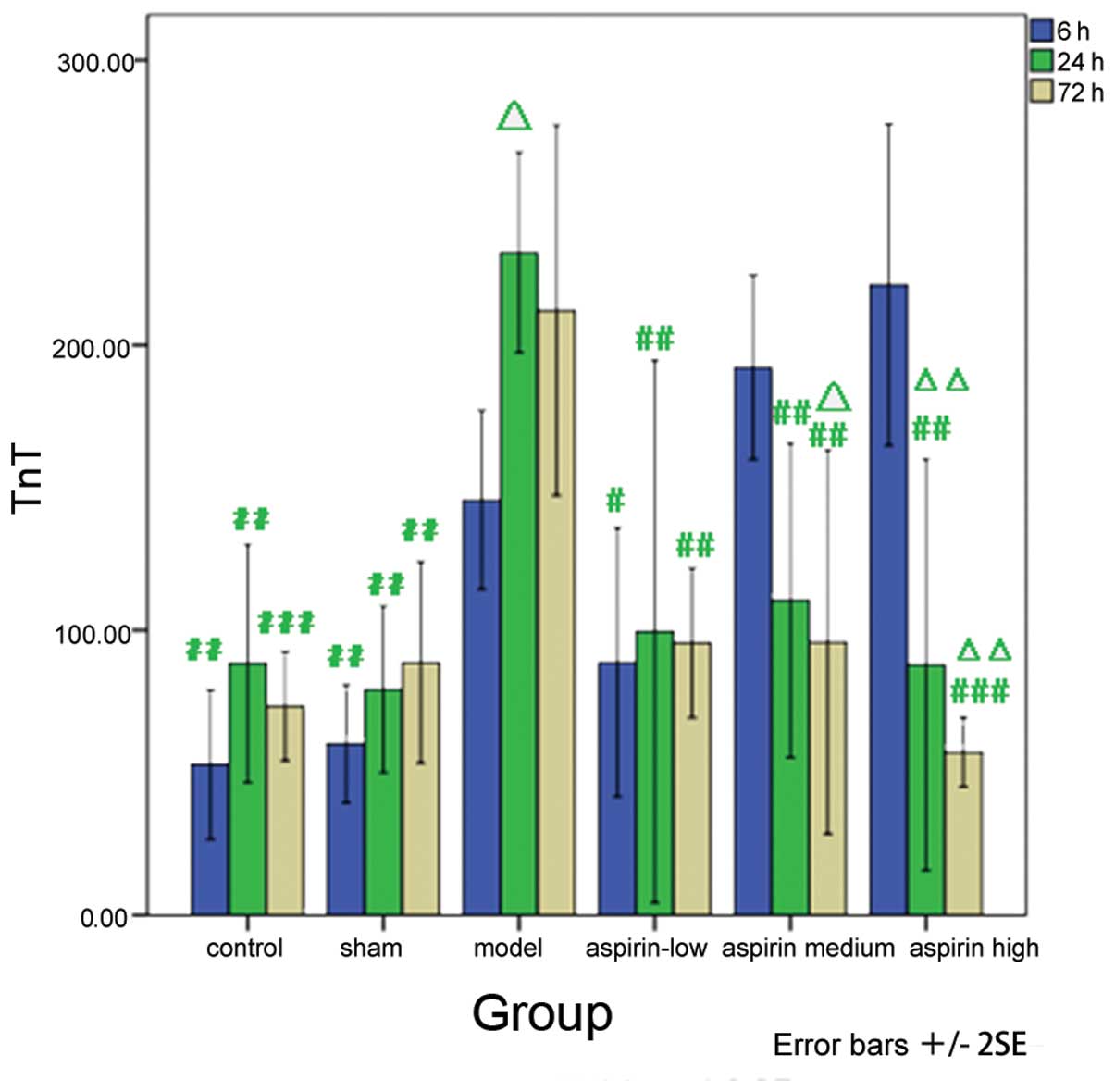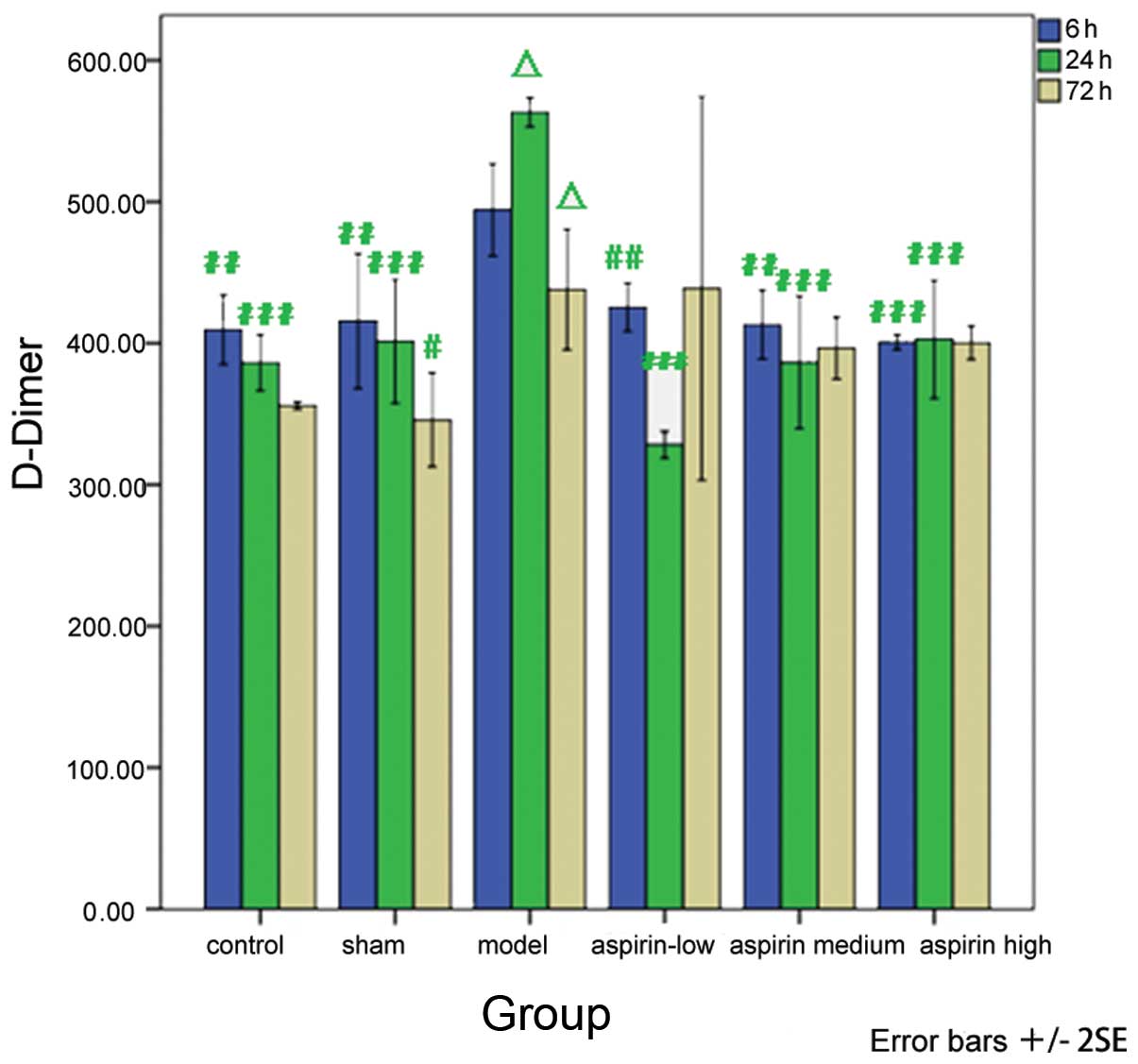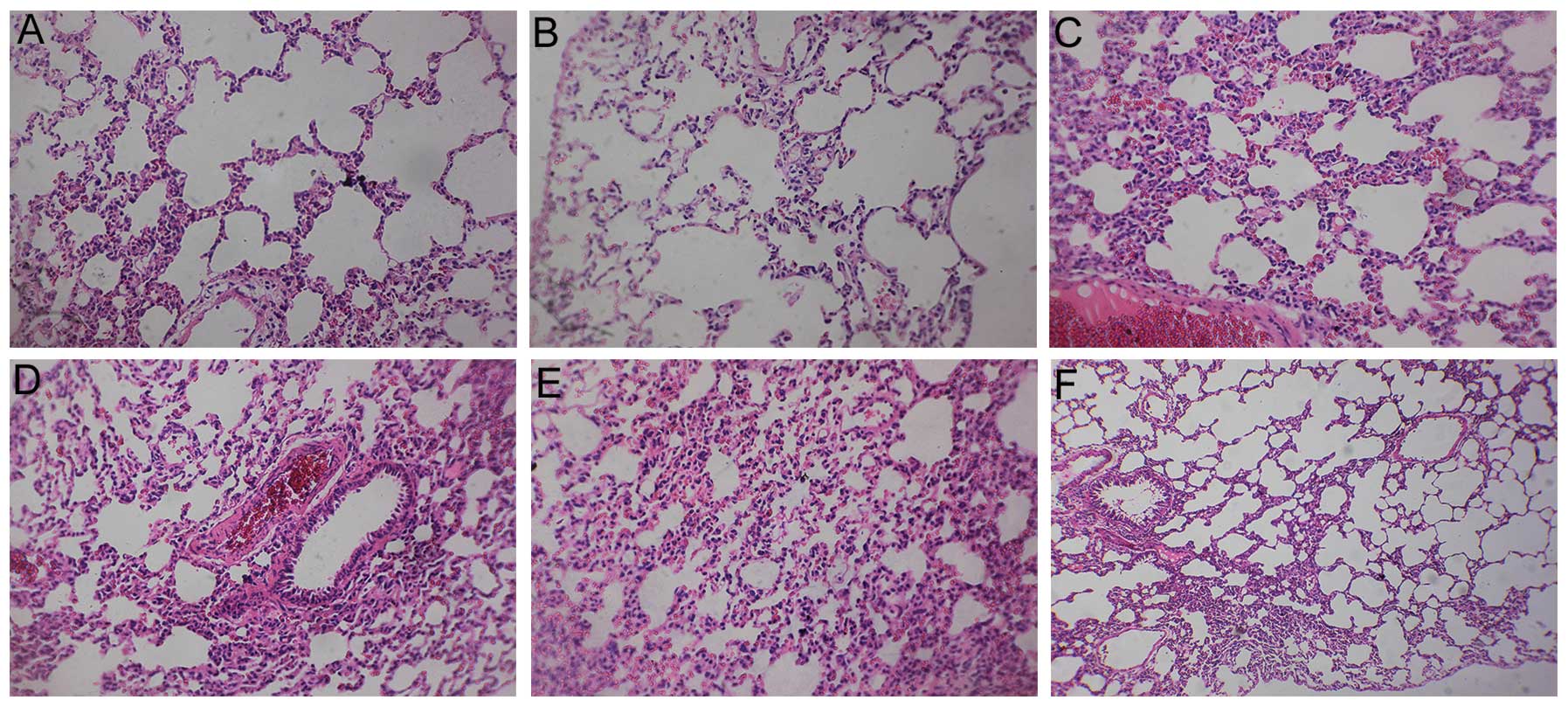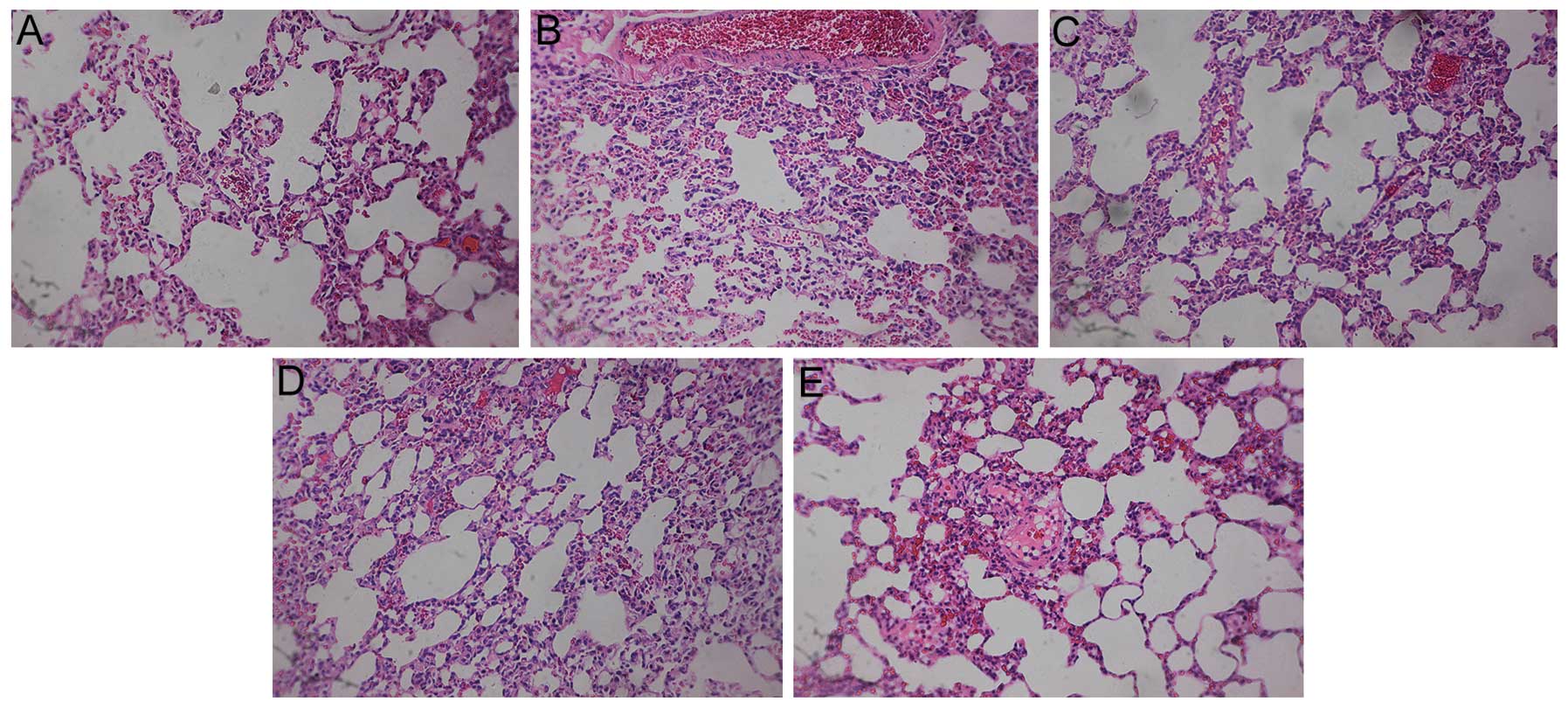Effects of aspirin on the ERK and PI3K/Akt signaling pathways in rats with acute pulmonary embolism
- Authors:
- Published online on: September 10, 2013 https://doi.org/10.3892/mmr.2013.1676
- Pages: 1465-1471
Abstract
Introduction
Inflammation is widely involved in the pathology of acute pulmonary embolism (APE), in which the levels of tumor necrosis factor (TNF)-α, interleukin (IL)-1β and IL-8 are significantly increased (1). It has been demonstrated that the use of aspirin may have protective effects (2). However, it has not yet been elucidated whether other important inflammatory factors are involved in the inflammatory responses following APE.
The European Society of Cardiology has issued ‘Guidelines on the diagnosis and management of acute pulmonary embolism’ (3), which suggested that brain natriuretic peptide (BNP), troponin (TnT) and D-Dimer may serve as prognostic markers of APE. A number of other studies have shown that extracellular signal-regulated protein kinases (ERK) (4–7) and phosphoinositide 3 kinase/protein kinase B (PI3K/Akt) (8) are important in the inflammatory response.
The ERK and PI3K/Akt signaling pathways have been demonstrated to be important in the pathology of lung injuries (4,5) and pulmonary arterial hypertension (9,10). However, no study has yet investigated the roles of these pathways in the pathology of APE.
In the present study, the effects of aspirin on the ERK and PI3K/Akt signaling pathways were studied in a rat model of APE. Furthermore, the levels of BNP, TnT and D-Dimer were used to predict the prognosis of the rats.
Materials and methods
Animals
A total of 108 Sprague Dawley rats bred in an ultra-clean environment, with body weights of ~250±20 g were used in this study. The animals were obtained from Huishan Jiangnan Animal Center, Wuxi, China [animal certification no. SCXK (Su) 2009–0005]. The Medical Experimental Animal Management Committee of Zhejiang, China, as well as the ethics committee of Zhejiang Chinese Medical University (Hangzhou, China), approved this study.
Drug
Aspirin enteric-coated capsules (W026) were obtained from Yongxin Pharmaceuticals Inc. (Kunshan, China).
Materials
PI3K antibody (BS3678; Bioworld, Dublin, OH, USA), Akt antibody (ab8805; Abcam, Cambridge, UK), ERK antibody (9102; Cell Signaling Technology, Inc., Danvers, MA, USA), β-actin antibody (sc-47778; Santa Cruz Biotechnology, Inc., Santa Cruz, CA, USA), goat anti-rabbit immunoglobulin G (IgG)-horseradish peroxidase (HRP) (BS13278; Bioworld) and goat anti-mouse IgG-HRP (BS12478; Bioworld) were used in this study. Cell culture plates (96-well) were obtained from Fisher Scientific International, Inc. (Hampton, NH, USA). The enzyme-labeling detection instrument (SpectraMax Plus 384) was obtained from Molecular Devices (Sunnyvale, CA, USA), while the electrophoresis (Mini-Protean® Tetra system) and gel imaging (ChemiDoc™ XRS+) systems were purchased from Bio-Rad (Hercules, CA, USA). The serum levels of BNP, TnT and D-Dimer were evaluated using enzyme-linked immunosorbent assay (ELISA) using commercially available kits (96T; Yifeng Biotechnology Co., Ltd., Shanghai, China).
Experimental design
A total of 108 Sprague-Dawley rats were randomly divided into six groups (n=18), based on their weight, by random numbers generated in SPSS (SPSS, Inc., Chicago, IL, USA). The groups included control, sham, model and low-, medium- and high-dose aspirin (150, 300 and 600 mg/kg, respectively). Rats were dosed once by gavage on day one and once again 40 min prior to surgery. Having established the model, the rats in each group were administered with the corresponding drugs by gavage at 6, 24 and 48 h. The rats in the control, sham and model groups were administered with 2 ml normal saline (NS) and the same volume was given to the aspirin dosing groups, once a day, for three consecutive days. In addition, the rats accessed water and solid food ad libitum throughout the experimental procedure.
Induction of the animal model
The rat model of APE was induced by the local injection of an autologous thrombus (11). Briefly, blood was collected from the orbital vein and the blood was allowed to clot at room temperature for 4 h. The clots were trimmed to ~2 mm3, prior to NS being added to suspend the clots. According to the body weights of the rats, different doses of chloral hydrate were injected for anesthetization. The right jugular vein was subsequently separated and jugular venous catheterization was performed. Following this, 0.5 ml of the thrombus suspension (containing ~15–20 clots) was injected into the rat using a 1 ml syringe. Rats in the sham group were administered with 0.5 ml NS via the right jugular vein, while the rats in the control group did not receive any intervention. The three aspirin groups were administered with aspirin on the basis of the APE model.
Analysis of ERK, PI3K, Akt, BNP, TnT and D-Dimer levels
Six rats were randomly selected at 6, 24 and 72 h subsequent to the induction of the APE model, respectively. The lungs and blood were then collected from the chloral hydrate-anesthetized rats and western blot analyses were used to evaluate the expression of ERK, PI3K and Akt. Briefly, the superior lobe of the left lung was collected for protein extraction. Following this, the protein concentration was determined using the bicinchoninic acid method, by measuring the absorbance at 562 nm and determining the protein concentration from a standard curve. Polyacrylamide gel electrophoresis was subsequently performed and the proteins were transferred to a polyvinylidene difluoride membrane and blocked. The proteins were incubated with primary antibody, prior to being washed and incubated with a secondary antibody. Enhanced chemiluminescent imaging was then performed and the optical density values of ERK, PI3K and Akt were compared with the optical density value of β-actin using ImageJ software (Rasband WS, National Institutes of Health, Bethseda, MD, USA). The levels of BNP, TnT and D-Dimer were measured using commercially available ELISA kits. Pulmonary pathology was also examined, as follows: Subsequent to the examination of the gross pathology of the lung, the lung tissue was fixed by 10% formalin for 24 h, prior to paraffin-embedded sections being prepared and stained with hematoxylin and eosin (H&E) reagents. Pathologists were asked to examine the pathological changes visible in the lung sections.
Statistical analysis
Experiments were performed independently at least three times. Statistical analyses were performed using the SPSS 19.0 statistical software package (SPSS, Inc.). Data are expressed as the arithmetic mean ± standard deviation. The results of the ELISA were compared using multi-factorial analysis of variance (ANOVA) and the western blot analyses were compared using one-way ANOVA followed by least significant difference or Student-Newman-Keuls tests. An α value of P<0.05 was considered to indicate a statistically significant difference.
Results
Western blot analysis
Compared with the model group, the levels of ERK, PI3K and Akt were significantly decreased in the control, sham and the three aspirin groups at the three time-points (P<0.001 or P<0.01) with the exception of the levels measured at 24 h in the medium-dose aspirin group (Tables I–III; Figs. 1–3). The results of the western blot analysis showed that the protein levels of ERK, PI3K and Akt were markedly higher in the model group than in the other groups (Fig. 4).
ELISA analysis
The levels of BNP, TnT and D-Dimer were compared with those of the model group at the corresponding time-points. The results showed that the levels were significantly lower in the control and sham groups than the model group at 6, 24 and 72 h subsequent to the model induction.
Decreased levels of BNP were observed in the aspirin- treated groups compared with the model group at the different time-points, with a significant decrease in BNP levels in the low-dose aspirin group at 6 h subsequent to model induction (P<0.05) and in the low-, medium- and high-dose aspirin groups 24 h subsequent to model induction (P<0.001). In addition, the results at different time-points were compared with the result at 6 h subsequent to model induction within each group. The results showed that at 24 h subsequent to model induction, the BNP levels significantly increased in the model group (P<0.01). However, the levels of BNP decreased significantly in the medium-dose aspirin group (P<0.05; Table IV and Fig. 5).
Similarly, as compared with the model group, the TnT levels were markedly decreased in the low-dose aspirin group at 6 h subsequent to model induction (P<0.05). A significant decrease in TnT levels was also observed in the low-, medium- and high-dose aspirin groups 24 h subsequent to model induction (P<0.01). In addition, the results obtained at the different time-points were compared with the observations made 6 h subsequent to model induction within each group. The results showed that the levels of TnT increased significantly in the model group 24 h subsequent to model induction (P<0.05). However, a significant decrease in the levels of TnT was observed in the medium (P<0.05) and high-dose aspirin (P<0.01) groups at 72 h and in the high-dose aspirin group at 24 h subsequent to model induction (P<0.01; Table V and Fig. 6).
With regard to the D-Dimer levels, a significant decrease was observed in the low-, medium- and high-dose aspirin groups at 6 and 24 h susbequent to model induction as compared with the model group (P<0.01 or P<0.001). When comparing the results at different time-points with the observations made 6 h subsequent to model induction within each group, it was revealed that the levels of D-Dimer were significantly increased 24 h subsequent to model induction (P<0.05) and significantly decreased 72 h subsequent to model induction (P<0.05) in the model group (Table VI and Fig. 7).
Pathological examination
In addition to the analysis of protein levels, pathological examinations of the lungs were performed. The structural integrity of the lung was maintained in the control and sham groups. However, pulmonary embolism, alveolar wall necrosis and alveolar hemorrhage were observed in the model group 6, 24 and 72 h subsequent to model induction. Indications of inflammatory cell infiltration and alveolar wall thickening and congestion were also observed. The congestion and inflammation were significantly attenuated following treatment with aspirin (Figs. 8–10).
Discussion
APE is one of the most important global health concerns, with a high incidence and mortality around the world. The incidence of APE is ~0.5% in Western countries and the mortality from APE is 25–30% for untreated patients. Studies have demonstrated that there is widespread inflammation following APE and the interaction between the blood clotting products and inflammatory cells aggravates pathological reactions (1,2,12).
In the present study, the levels of factors involved in inflammation, such as ERK, PI3K and Akt, were observed to markedly change following APE. Mitogen-activated protein kinase pathways are important intracellular signaling pathways, among which the ERK signaling pathway is closely associated with cell proliferation (13). There are two closely related ERK isoforms, ERK1 and ERK2, which are often referred to as ERK1/2. A number of factors, including growth factors, irradiation and hydrogen peroxide, phosphorylate ERK1/2 to P-ERK1/2, which is subsequently transported into the nucleus where it interacts with transcription factors, such as nuclear factor-κB (NF-κB), to regulate the transcription of target genes. The activation of target genes, in turn, affects the function and metabolic activity of the cells and affects cell proliferation and the synthesis of protein and collagen (14).
The enhanced expression of P-ERK1/2 has been demonstrated in the lung tissues of rats with acute lung injury induced by lipopolysaccharide (LPS) (4), which suggests that ERK is critical in the inflammatory reactions mediated by TNF-α and IL-12. In the study by Shi et al(6), these observations were further supported when it was shown that LPS activated the ERK pathway and induced the expression of TNF-α. The activation of the ERK pathway may be important in the synthesis and secretion of inflammatory factors by macrophages (7), indicating that ERK is important in the process of inflammatory reactions.
By contrast, the PI3K/Akt pathway is an intracellular signaling pathway, which affects cell proliferation, apoptosis and differentiation. PI3K is widely distributed in the lung, heart and brain. PI3K/Akt consists of two subunits, p110 (a 110×103 kDa catalytic subunit) and p85 (an 85×1,000 kDa regulatory subunit) (15). Akt, also known as protein kinase B, is a serine/threonine protein kinase (16) and is the downstream target protein of PI3K. The PI3K/Akt pathway may mediate the activation and migration of immune/inflammatory cells and be important in the pathology of asthma.
A previous study (8) demonstrated that there was a significant upregulation of Akt in rats with experimental asthma and that the expression of PI3K/Akt was also significantly higher than that observed in the control group. In addition, a number of other studies have shown that the PI3K/Akt pathway is involved in the pathology of hypoxic pulmonary hypertension, while a PI3K/Akt pathway inhibitor prevented pulmonary hypertension (9,10). Furthermore, the PI3K/Akt pathway participates in inflammatory responses and hypoxia. However, no study has yet investigated the expression of ERK, PI3K and Akt following APE, and only very few studies have explored the effects of aspirin on the expression of ERK and PI3K/Akt (17,18).
In the present study, increased levels of ERK, PI3K and Akt were observed in the lung tissues at 6, 24 and 72 h subsequent to model induction. By contrast, treatment with different doses of aspirin resulted in the decreased expression of these proteins, suggesting that aspirin may downregulate the expression of ERK, PI3K and Akt in rat lungs. Downregulation in these signaling pathways may, in turn, inhibit the expression of the inflammatory cytokines TNF-α, IL- 1β and IL-8 (1) and attenuate the inflammatory responses following APE.
The characteristics of APE are alveolar wall necrosis and hemorrhage. In the present study, the pathological changes that were observed demonstrated that the model was induced successfully and that aspirin was capable of ameliorating the congestion and inflammation of the lung. This indicated that the inhibition of ERK, PI3K and Akt was potentially the mechanism involved in the protective effects of aspirin.
The ‘Guidelines on the diagnosis and management of acute pulmonary embolism’ (3) have recommended that the levels of prognostic markers, such as serum BNP, TnT and D-Dimer, are evaluated, since this may be beneficial for the prediction of the prognosis of patients with APE at an early stage. Low levels of BNP, TnT and D-Dimer have been correlated with a favorable prognosis, such as lower mortality and positive outcomes. In patients with APE, the sharply increased right ventricular pressure may compress the right coronary artery and result in myocardial damage; the balance of oxygen supply/demand in the right ventricle may also be disturbed, leading to an increased expression of TnT.
BNP is always secreted by ventricular myocytes. Ventricular dilatation is capable of stimulating the synthesis and secretion of BNP, which is not always interrelated with the function of the right ventricle. D-Dimer is a degradation product of cross-linked fibrin. As a specific fibrinolytic marker, D-Dimer is widely used in the diagnosis of APE. Although the specificity of D-Dimer in diagnosing APE is relatively low, the sensitivity is high. In the present study, significant increases were observed in the serum levels of BNP, TnT and D-Dimer in the model group 6 and 24 h subsequent to model induction, particularly at 24 h. At the 72-h time-point, the serum levels of BNP, TnT and D-Dimer began to decrease. However, treatment with aspirin significantly decreased the levels of BNP, TnT and D-Dimer, suggesting that aspirin treatment may result in a more favorable prognosis. Moreover, serum levels of BNP, TnT and D-Dimer may be important in the protective effects of aspirin.
In conclusion, treatment with aspirin reduced lung damage in a rat model of APE and improved the prognosis of the rats. Decreased expression levels of ERK, PI3K and Akt in the lungs of rats with APE and reduced serum levels of BNP, TnT and D-Dimer may be important in these effects.
Acknowledgements
This study was funded by the Zhejiang Provincial Natural Science Foundation of China (grant no. LY12H29005).
References
|
Liu YC, Kao SJ, Chuang IC and Chen HI: Nitric oxide modulates air embolism-induced lung injury in rats with normotension and hypertension. Clin Exp Pharmacol Physiol. 34:1173–1180. 2007.PubMed/NCBI | |
|
Sheu JR, Hsiao G, Lee YM and Yen MH: Antithrombotic effects of tetramethylpyrazine in in vivo experiments. Int J Hematol. 73:393–398. 2001. View Article : Google Scholar : PubMed/NCBI | |
|
Torbicki A, Perrier A, Konstantinides S, et al: Guidelines on the diagnosis and management of acute pulmonary embolism: the task force for the diagnosis and management of acute pulmonary Embolism of the European Society of Cardiology (ESC). Eur Heart J. 29:2276–2315. 2008. View Article : Google Scholar : PubMed/NCBI | |
|
Liu Z, Yang Z, Fu Y, et al: Protective effect of gossypol on lipopolysaccharide-induced acute lung injury in mice. Inflamm Res. 62:499–506. 2013. View Article : Google Scholar : PubMed/NCBI | |
|
Jiang JX, Zhang Y, Ji SH, Zhu P and Wang ZG: Kinetics of mitogen-activated protein kinase family in lipopolysaccharide-stimulated mouse Kupffer cells and their role in cytokine production. Shock. 18:336–341. 2002. View Article : Google Scholar | |
|
Shi L, Kishore R, McMullen MR and Nagy LE: Lipopolysaccharide stimulation of ERK1/2 increases TNF-α production via Egr-1. Am J Physiol Cell Physiol. 282:C1205–C1211. 2002. | |
|
Jarrar D, Kuebler JF, Rue LW III, et al: Alveolar macrophage activation after trauma-hemorrhage and sepsis is dependent on NF-κB and MAPK/ERK mechanisms. Am J Physiol Lung Cell Mol Physiol. 283:L799–L805. 2002.PubMed/NCBI | |
|
Yadav UC, Naura AS, Aguilera-Aguirre L, et al: Aldose reductase inhibition prevents allergic airway remodeling through PI3K/AKT/GSK3β pathway in mice. PLoS One. 8:e574422013.PubMed/NCBI | |
|
Banquet S, Delannoy E, Agouni A, et al: Role of Gi/o-Src kinase-PI3K/Akt pathway and caveolin-1 in β2-adrenoceptor coupling to endothelial NO synthase in mouse pulmonary artery. Cell Signal. 23:1136–1143. 2011. | |
|
Yang D, Liu Z, Zhang H and Luo Q: Ghrelin protects human pulmonary artery endothelial cells against hypoxia-induced injury via PI3-kinase/Akt. Peptides. 42:112–117. 2013. View Article : Google Scholar : PubMed/NCBI | |
|
Diaz JA, Obi AT, Myers DD Jr, et al: Critical review of mouse models of venous thrombosis. Arterioscler Thromb Vasc Biol. 32:556–562. 2012. View Article : Google Scholar : PubMed/NCBI | |
|
Smulders YM: Pathophysiology and treatment of haemodynamic instability in acute pulmonary embolism: the pivotal role of pulmonary vasoconstriction. Cardiovasc Res. 48:23–33. 2000. View Article : Google Scholar : PubMed/NCBI | |
|
Yu PJ, Ferrari G, Pirelli L, et al: Vascular injury and modulation of MAPKs: a targeted approach to therapy of restenosis. Cell Signal. 19:1359–1371. 2007. View Article : Google Scholar : PubMed/NCBI | |
|
Eblen ST, Slack JK, Weber MJ and Catling AD: Rac-PAK signaling stimulates extracellular signal-regulated kinase (ERK) activation by regulating formation of MEK1-ERK complexes. Mol Cell Biol. 22:6023–6033. 2002. View Article : Google Scholar : PubMed/NCBI | |
|
Voigt P, Brock C, Nurnberg B and Schaefer M: Assigning functional domains within the p101 regulatory subunit of phosphoinositide 3-kinase γ. J Biol Chem. 280:5121–5127. 2005.PubMed/NCBI | |
|
Lin CH, Yeh SH, Lin CH, et al: A role for the PI-3 kinase signaling pathway in fear conditioning and synaptic plasticity in the amygdala. Neuron. 31:841–851. 2001. View Article : Google Scholar : PubMed/NCBI | |
|
El Kebir D, Jozsef L, Khreiss T, et al: Aspirin-triggered lipoxins override the apoptosis-delaying action of serum amyloid A in human neutrophils: a novel mechanism for resolution of inflammation. J Immunol. 179:616–622. 2007.PubMed/NCBI | |
|
Tsai KS, Yang RS and Liu SH: Benzo[a]pyrene regulates osteoblast proliferation through an estrogen receptor-related cyclooxygenase-2 pathway. Chem Res Toxicol. 17:679–684. 2004. |



